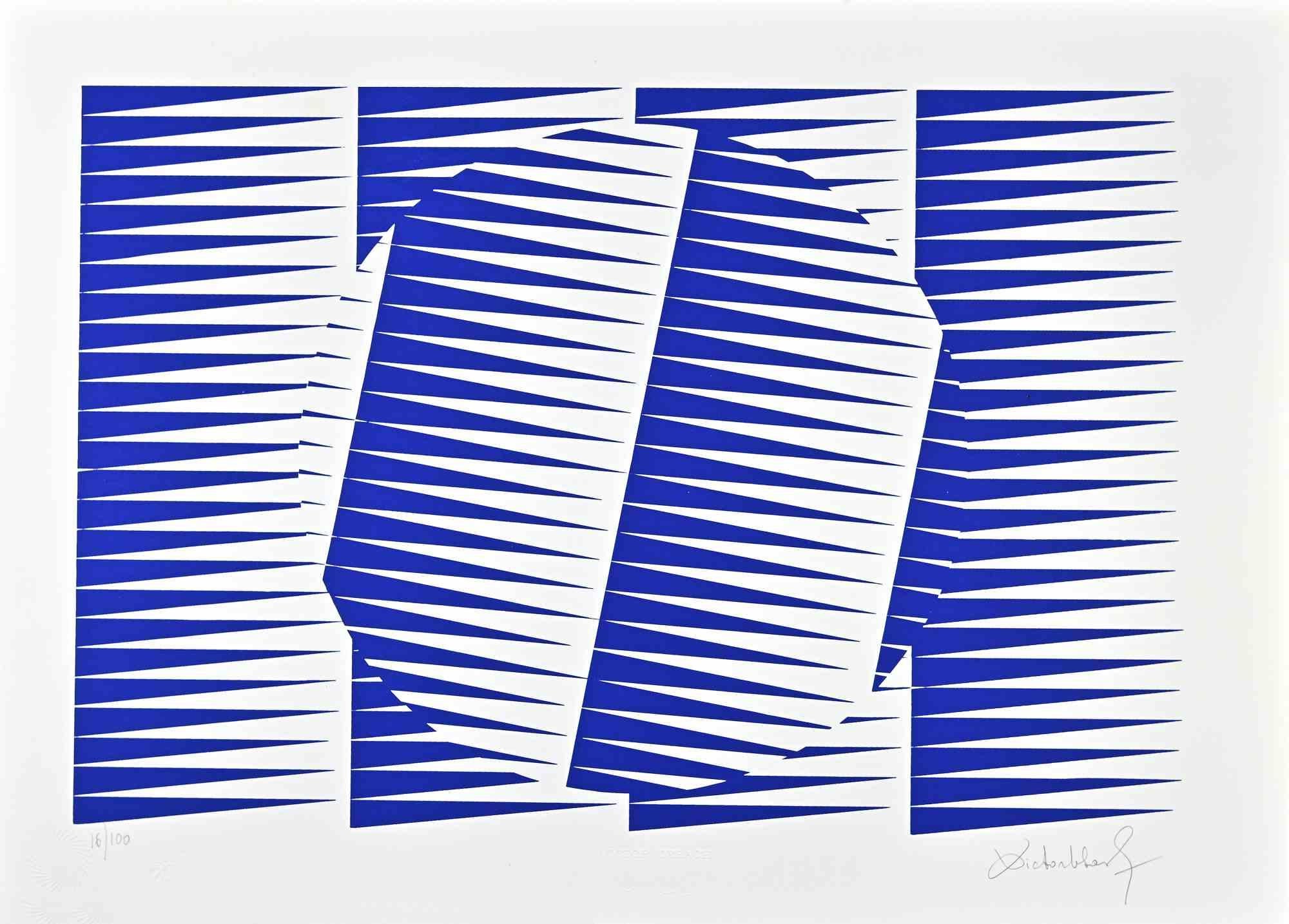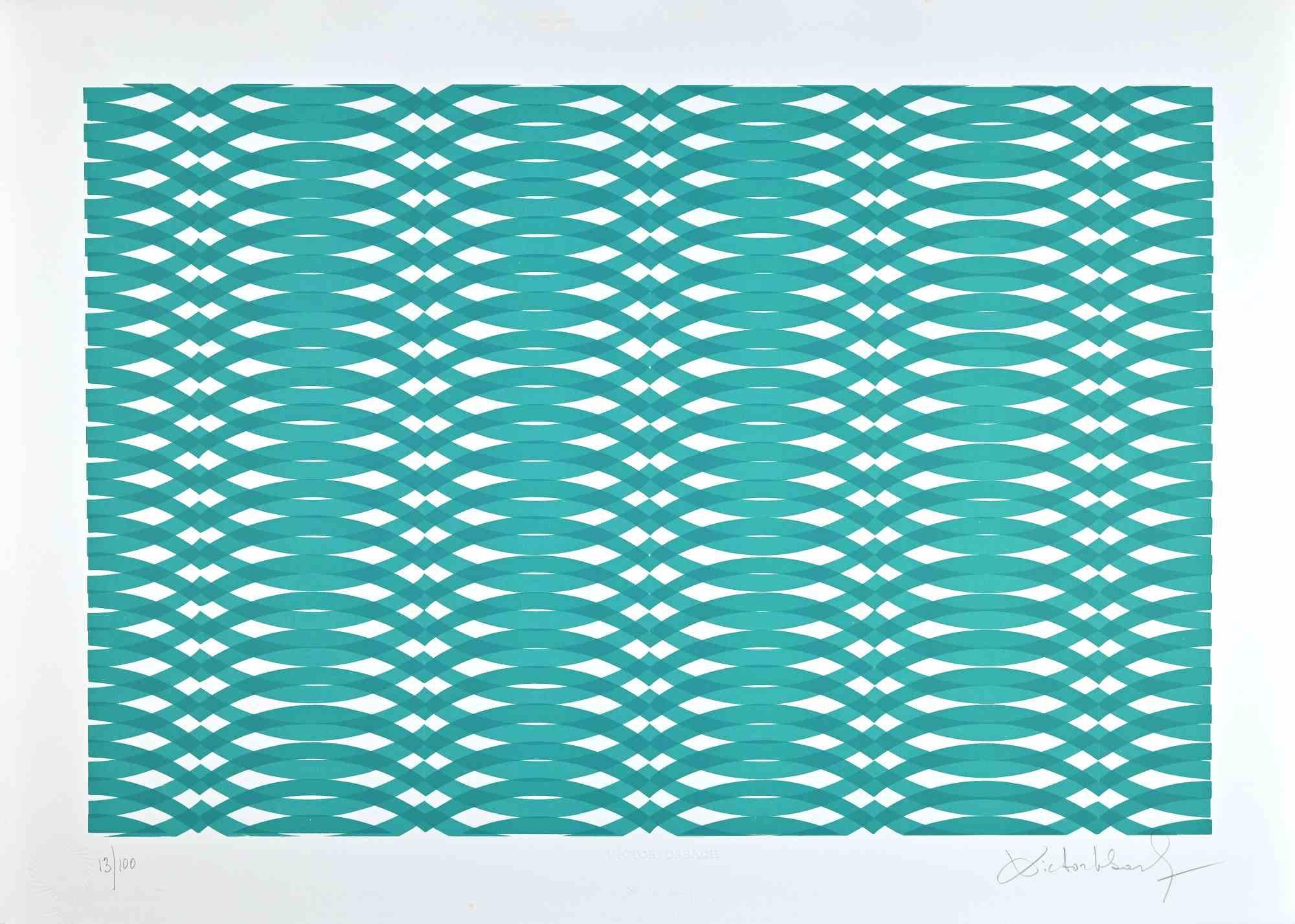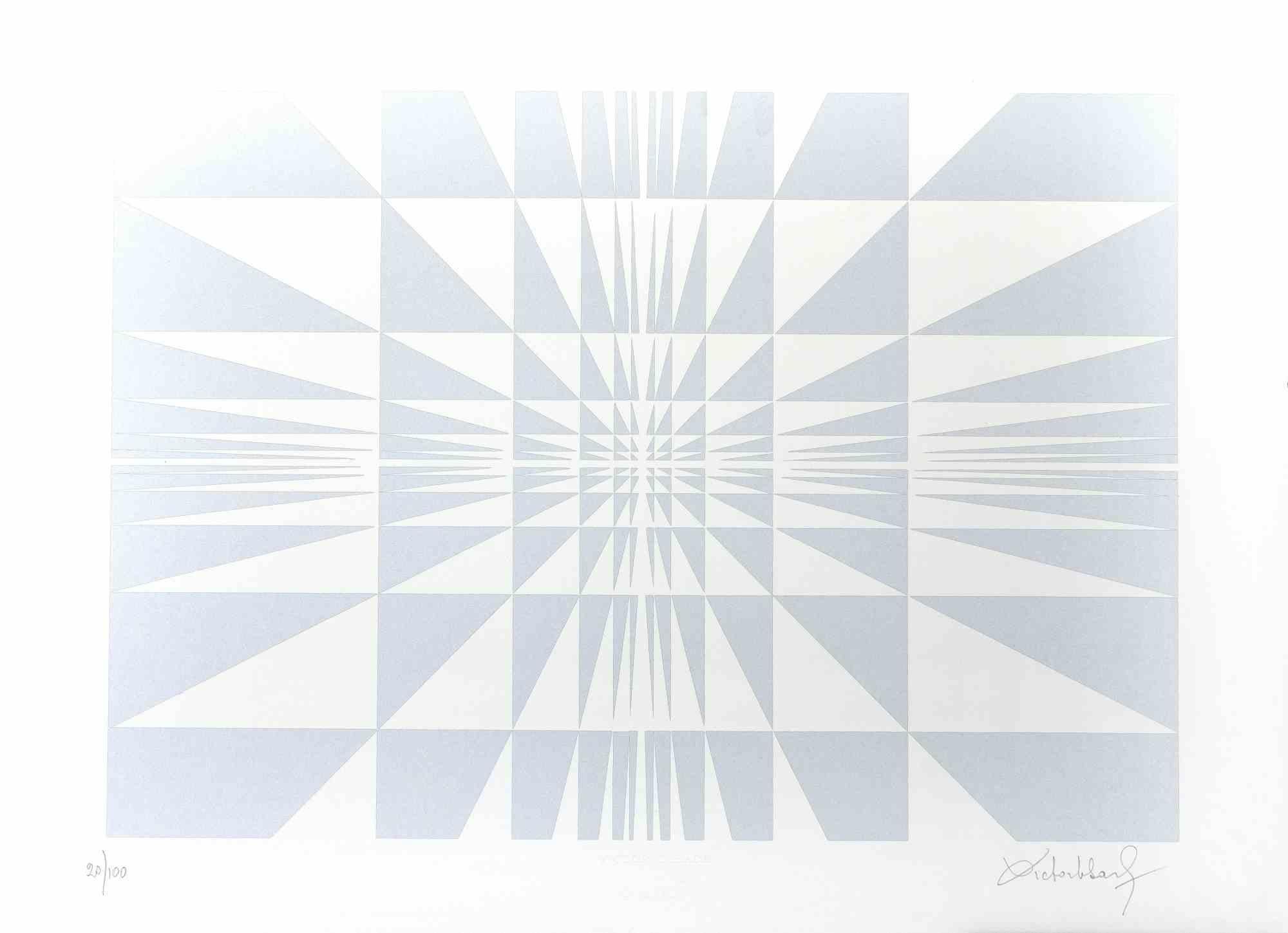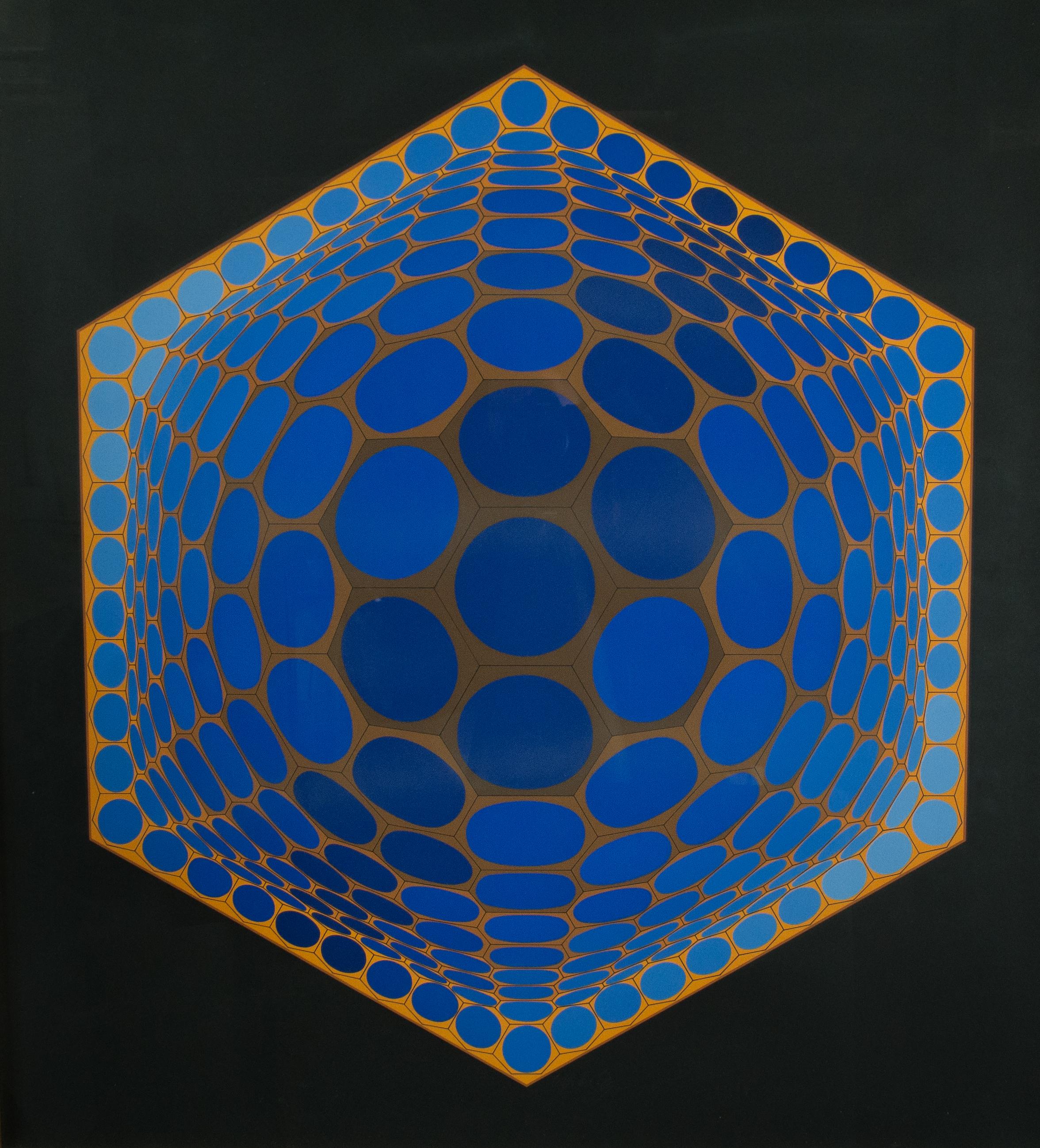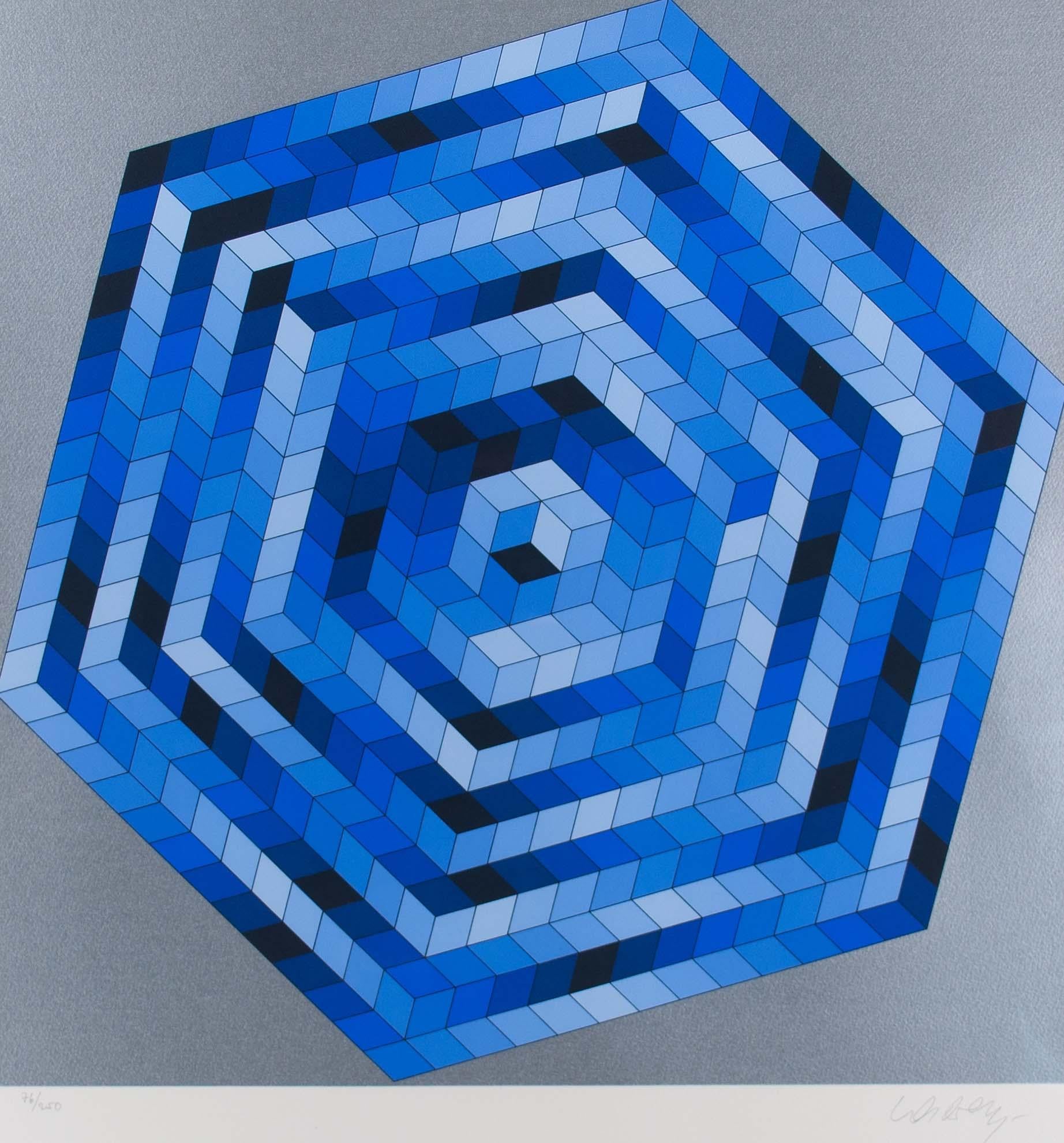Victor VasarelyBanya, 1964 Vintage Abstract Op Art Screen Print Serigraph 1964
1964
About the Item
- Creator:Victor Vasarely (1906 - 1997, French, Hungarian)
- Creation Year:1964
- Dimensions:Height: 23.5 in (59.69 cm)Width: 23.5 in (59.69 cm)
- Medium:
- Movement & Style:
- Period:
- Condition:Good condition, frame needs some fastening.
- Gallery Location:Surfside, FL
- Reference Number:1stDibs: LU38211300392
Victor Vasarely
Widely considered the grandfather of Op art, the French-Hungarian painter Victor Vasarely (1906–97) created eye-popping geometric abstractions that play with the viewer’s perception of depth, perspective and motion. A classic example is the 1937 Zebra, which consists of undulating black and white stripes that suggest the form of the titular animal through optical trickery. The work is often credited as the earliest Op art painting.
Such illusions were more than pleasing tricks for Vasarely, who insisted that “pure form and pure color can signify the world.” He wanted to “democratize” art by producing works in large editions at reasonable prices that were understandable across national and cultural boundaries. In the 1960s, he developed an alphabet plastique, or fine art alphabet, consisting of elementary visual building blocks that could be used in endless combinations to create original compositions. By employing this universal visual vocabulary and stripping away topical references, he sought to create what he called a “Planetary Folklore.”
Embodying Vasarely’s singular belief that art should serve a social function, accessible to all, these innovations may perhaps be his greatest contribution to 20th-century art.
Find a collection of Victor Vasarely prints, paintings, sculptures and other art on 1stDibs.
- ShippingRetrieving quote...Ships From: Surfside, FL
- Return PolicyA return for this item may be initiated within 3 days of delivery.
- Agam Silkscreen Mod Judaica Lithograph Hand Signed Israeli Kinetic Op Art PrintBy Yaacov AgamLocated in Surfside, FLYaacov Agam Israeli (b. 1928) Hommage aux Prix Nobel (1974) Serigraph signed lower right, numbered 85/100 sheet: 22 x 29 3/4 inches frame dimensions: 28 x 35 1/2 x 1 inches, wood fra...Category
1990s Op Art Abstract Prints
MaterialsLithograph, Screen
- Yaacov Agam Large Silkscreen Colors on Gold Signed Israeli Kinetic Op Art PrintBy Yaacov AgamLocated in Surfside, FLThis is a large hand signed serigraph silkscreen, pencil numbered in Roman numerals. biographical info: The son of a rabbi, Agam can trace his ancestry back six generations to the f...Category
20th Century Op Art Abstract Prints
MaterialsScreen
- Op Art, Kinetic 1970s Original Vintage Silkscreen Lithograph PrintBy David RothLocated in Surfside, FLHand signed and numbered limited edition print. David Roth studied at the Illinois Institute of Technology's Institute of Design and was twice the recipient of the Moholy-Nagy Scholarship in visual design. It was Roth's initial work as a designer at fine art for commercial use that brought him interesting positions as art director for Lanvin, Charles at the Ritz, and Germain Monteil. . The strings are tied in bunches and closely hung tram a wooden bar. The size and shape of the string is similar to that at a canvas painting. Each bundle is represented by a vertical row at squares on the graph and the groupings at string are lined up along the wall according to the horizontal rows at the program. The six primary and secondary colors are used in their full intensity along with black, grey, and white. As a painter Roth works to formulate with color. Some painters regard color as a concomitant of form, hence a subordinate, but Roth's color is the chief medium of his pictorial language. A programmed juxtaposition at primary color allows Roth and the viewer to play upon various combinations. The graphs Roth executes are proportioned according to a strict mathematical formula - the pictures are Composed according to horizontal and vertical divisions on the graph paper. The optical quality of color, deliberately sought, has its roots in the Bauhaus investigations of illusion, and thus has a direct relationship to the Op art produced in postwar Europe. Roth has arranged his hues so as to persuade the planes to separate from the ground on which they are planted, and float free in space. It is almost as if Roth is giving us a "readout" on his creative process. Although the graphs appear to vary in their use of color the same colors are used throughout, also the same amount of color. Roth's work illustrates the sophistication of the human eye-brain relationship that has developed and invites the viewer to participate in the evolution at visionary ideas. One Man Shows 1966 The Gallery Upstairs, Buffalo, New York 1967 The Gallery Upstairs, Buffalo, New York 1969 The House of Graphics, New York 1969 Illinois Institute of Technology, Chicago, Illinois 1972 Robert Elkon Gallery, New York 1973 Robert Elkon Gallery, New York 1974 Robert Elkon Gallery, New York 1975 Michael Wyman Gallery, Chicago 1975 Robert Elkon Gallery, New York 1976 G.W. Einstein, New York 1976 Robert Elkon Gallery, New York 1977 Robert Elkon Gallery, New York 1977 G.W. Einstein, New York 1978 Sunne Savage Gallery, Boston, Massachusetts 1978 Robert Elkon Gallery, New York 1979 Nancy Roth Gallery, Katonah, New York Group Exhibitions 1967 State University of New York, Buffalo 1970 Ronald Feldman Gallery 1970 The Everyman Gallery 1971 Robert Elkon Gallery, New York 1972 The Brooklyn Museum, New York 1972 The Newark Museum, New Jersey 1972 Art...Category
1970s Op Art Abstract Prints
MaterialsScreen
- Agam 1971 Kinetic Op Art Print signed and datedBy Yaacov AgamLocated in Surfside, FLGenre: Kinetic Subject: Abstract Medium: Print Surface: Paper Image Dimensions: 14 x 16 Overall Dimensions: 26 3/4" x 26 3/4" This artwork epitomizes Yaacov Agam's kinetic style. Hi...Category
1970s Op Art Abstract Prints
MaterialsScreen
- Agam Silkscreen Jerusalem Lithograph Hand Signed Israeli Kinetic Op Art PrintBy Yaacov AgamLocated in Surfside, FLYaacov Agam, Israeli (b. 1928) Hand signed, not individually numbered but from edition of 180. I can include a copy of the title sheet with the edition size and his signature if you ...Category
1980s Op Art Abstract Prints
MaterialsLithograph, Screen
- Agam Silkscreen Mod Judaica Lithograph Hand Signed Israeli Kinetic Op Art PrintBy Yaacov AgamLocated in Surfside, FLYaacov Agam Israeli (b. 1928) Hand signed, not individually numbered but from edition of 180. I can include a copy of the title sheet with the edition size and his signature if you r...Category
1980s Op Art Abstract Prints
MaterialsLithograph, Screen
- Abstract Silver Composition - Screen Print by Victor Debach - 1970sBy Victor DebachLocated in Roma, ITAbstract Silver Composition is a Screen Print on Paper realized by Victor Debach in 1970s. Limited edition of 100 copies numbered and signed by the artist with pencil on the lower m...Category
1970s Op Art Abstract Prints
MaterialsScreen
- TallerOrBy Victor VasarelyLocated in Fairlawn, OHTallerOr Screen print printed on "card board" (cream poster board), 1968 Signed and numbered in pencil Edition: 150 (54/150), plus 11 for the Vasarely Fou...Category
1960s Op Art Abstract Prints
MaterialsScreen
- Abstract Composition in Light Green - Screen Print by Victor Debach - 1970sBy Victor DebachLocated in Roma, ITAbstract composition in light green is a Screen Print on Paper realized by Victor Debach in 1970s. Limited edition of 100 copies numbered and signed by the artist with pencil on the...Category
1970s Op Art Abstract Prints
MaterialsScreen
- Abstract Electric Blue Composition - Screen Print by Victor Debach - 1970sBy Victor DebachLocated in Roma, ITAbstract Electric Blue Composition is a screen Print on Paper realized by Victor Debach in the 1970s. Limited edition of 100 copies numbered and signed by the artist with pencil on ...Category
1970s Op Art Abstract Prints
MaterialsScreen
- UntitledBy Victor VasarelyLocated in Ljubljana, SIUntitled. Original color silkscreen, cca. 1980. Edition of 200 signed and numbered impressions on Arches paper. Victor Vasarely was a French painter of Hungarian origin. Influenced b...Category
1980s Op Art Abstract Prints
MaterialsScreen
- UntitledBy Victor VasarelyLocated in Ljubljana, SIUntitled. Original color silkscreen, cca. 1980. Edition of 250 signed and numbered impressions on Arches paper. Victor Vasarely was a French painter of Hungarian origin. Influenced b...Category
1980s Op Art Abstract Prints
MaterialsScreen
